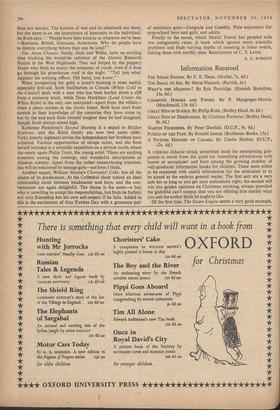Information Received
A PICTURE HISTORY OF CANADA. By Clarke Hutton. (0.U.P.,
12s. 6d.)
A LURKING didactic streak sometimes leads the enterprising god- parent to revolt from the quest for 'something adventurous with horses or aeroplanes' and hunt among the growing number of well-produced informative books for children. These seem either to be crammed with useful information for the enthusiast or to be aimed at the embryo general reader. The first sort are a very safe bet as long as you get your enthusiasm right; the second will win you golden opinions on Christmas morning, always provided the godchild can't suspect that you are offering him merely what you and the author think he ought to like.
Of the first type, The Steam Engine seems a very good example,
being the latest of the popular 'True Books' series. It is sad to reflect that it all begati with a hoax in AD 50 when hot-air power was used to make temple doors at Alexandria fly open without human aid. Thereafter, however, one is taken clearly and exhaus- tively from Leonardo to the Charlotte Dundas and thence to the atomic power-house. The illustrations are adequate in number and doubtless ablindantly clear to the competent schoolboy for whom the book is meant.
Too Small to See is an excellent 6s.-worth for the insect man of 8-10. In brightly coloured, simple and magnified diagrams he can learn enough about the habits of flies, bees, mites and microbes to send him off for more to the library and to fill the house with horrid tins of specimens and victims.
Eric Partridge's What's the Meaning? is a word anthology which never talks down to the intelligent twelve-year-old for whom it would be an interesting novelty and who would delight in discovering how to write a letter to the Pope or that his father's name really means 'a barbarous Scythian.'
Champion Roues and Ponies, though barely a child's book, is crammed with technical knowledge for the fanatical horse-lover, who would welcome it anyway for more than a hundred large Photographs.
When looking for a book of a more general nature, you may well meet the new 'Great Men of the Counties' series. Each volume deals with six regional worthies and the idea at first sight seems rather a desperate and artificial expedient. In Great Men of Sussex Philip Rush has to drag in mere residents, like Kipling, or mere females, like Phcebe Hessel, to swell the ranks of the county's great. The Derbyshire volume converted me by its good narrative and fascinating detail, and, after meeting Brindley, Bess of Hard- wick and Sir James Outram, I was ready to believe that Derbyshire men have a regional gumption of their own.
Another new series is the OUP's 'Great Seamen,' which began with Ronald Welch's Magellan and now continues with Martin rrobisher by Peter Dawlish with evocative and apposite black and white illustrations by William Stubbs. This stolid Yorkshire- man, overshadowed by his flashier contemporaries, comes con- vincingly to life in a narrative refreshingly free of the tushery so often associated with the Sea Dogs. The period background of war and politics is there in unportentous proportiens. The three Arctic voyages are excellently done and should even send some hotfoot to Hakluyt—and not only the boys.
Puzzle of the Past is a most attractive-looking book, almost overloaded with coloured illustrations and clearly and interestingly written. Its appearance is obviously meant to temper the fairly stiff subject matter, which is the history of archwology, no less, and its growth from a hobby into a science. The younger child, attracted by the pictures, would still be baffled by the presentation, which, of necessity, scraps ordinary chronology and hops from Egypt to Sutton Hoo and back to Knossos in pursuit of its theme. To the TV-conscious fifteen-year-old it should prove a useful Introduction to a fashionable and rewarding interest.
A Picture History of Canada is a shining example of the success- ful quest for the general reader. The dust jacket tersely says 'all ages' and this has proved no idle boast so far on guinea pigs of 4-34. It is packed With really vivid pictures and the very compact text whets a diversity of appetites, tragical-comical-historical- Pastoral. It should send any child on further exploration with the Indians, voyageurs, railwaymen and prospectors—provided it is not seized upon by too many teachers of history and geography as the ideal school prize. HELEN M. LYLB Changing the World, by Amabel Williams-Ellis (Bodley Head, 9s. 6d.), is a fragile little book, adequately illustrated, which has been written by a woman who is never pretentious. It relates quite a number of things about scientists who, despite the title, seem to have been singled out because the authoress liked them. It is a welcome contrast to the scientific waffle of the know-alls. Warmly recommended for children, ten years old and more.
JOHN HILLABY
(Children's books continued on page 794)



















































 Previous page
Previous page